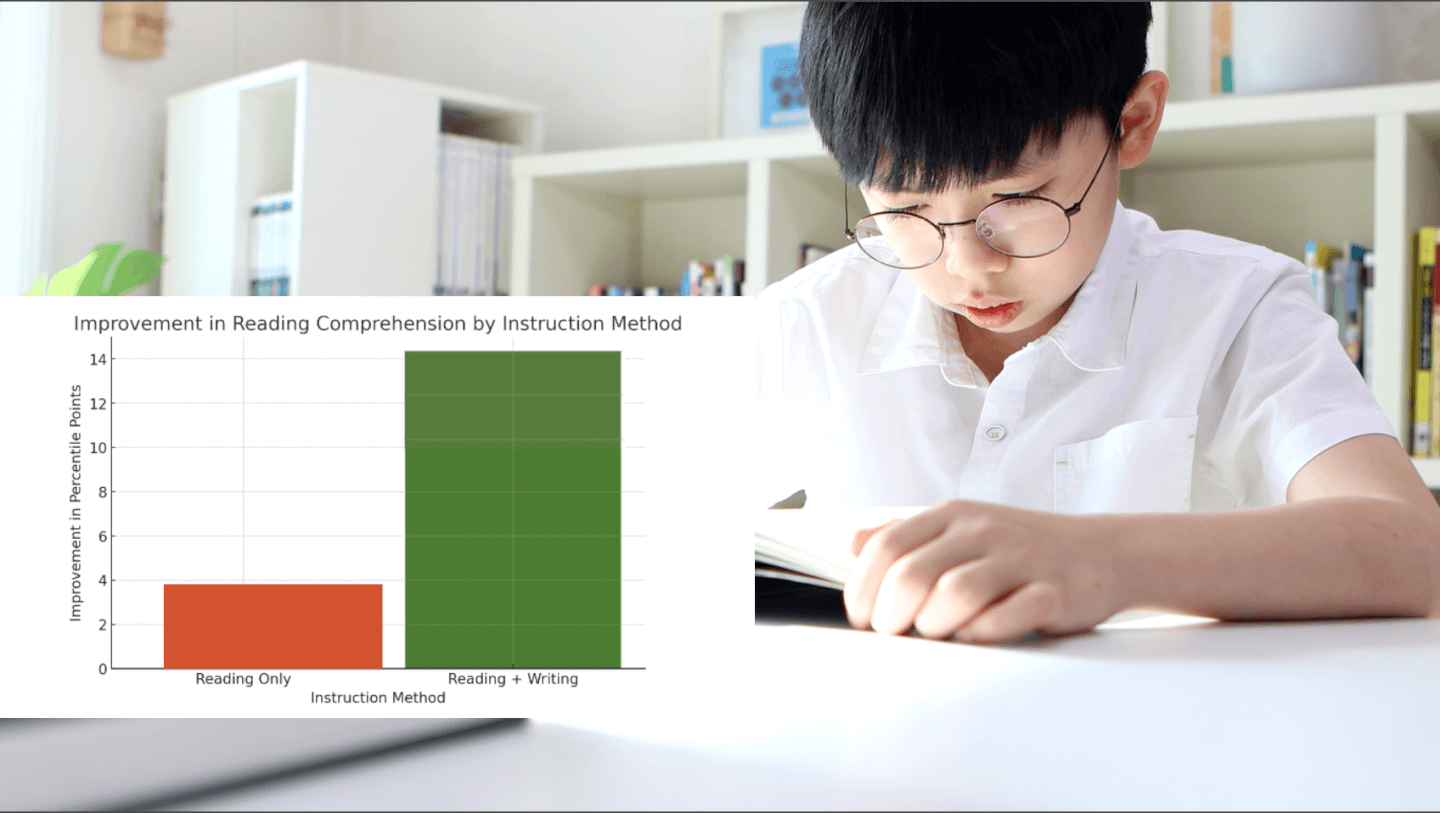Enhance Student Writing: The Role of Reading for Writing

The 2018 meta-analysis “Reading for Writing: A Meta-Analysis of the Impact of Reading Interventions on Writing” conducted by Steve Graham and his team, including Xinghua Liu, Brendan Bartlett, Clarence Ng, Karen R. Harris, and others, provides comprehensive insights into how reading interventions influence writing skills. The research explored 54 experiments, analyzing 5,018 students’ writing performance after reading interventions. This extensive study addressed two central questions:
- Does teaching reading enhance writing performance?
- Does increasing students’ interaction with words or text through reading or observing others read improve their writing?
These findings have broad implications for classroom instruction, especially in light of the strong statistical results showing the efficacy of reading interventions on writing improvement. The meta-analysis also suggests that writing and reading are deeply connected, building on standard cognitive processes. This blog will discuss the findings and how teachers can apply these insights to improve students’ writing.
Key Findings of the Reading for Writing Meta-Analysis
1. Teaching Reading Improves Writing Performance
The analysis found that teaching reading significantly improves students’ writing abilities across multiple dimensions. The overall effect size was 0.57, indicating that reading instruction substantially boosted writing performance. In particular, reading interventions improved writing quality (0.63), spelling (.56), and even the quantity of words written (.37).
An effect size is a number that shows how much of an impact something has—in this case, how much teaching reading improves students’ writing performance. An effect size of 0.57, like the one found here, is considered significant, with anything above 0.40 viewed as having a meaningful impact in educational settings.
The study examined several types of reading interventions, including phonological awareness, phonics, vocabulary instruction, and reading comprehension. These reading approaches improved writing outcomes, particularly in spelling and writing quality. For example, phonological awareness and phonics instruction were especially effective in improving spelling skills.
This demonstrates that teaching students to decode and understand text also prepares them to create coherent, well-structured writing. Phonological awareness instruction yielded the highest effect size of 0.69, showing that improving students’ ability to understand sound-letter correspondences improved their spelling and, consequently, their overall writing.
2. Increased Interaction with Text Also Enhances Writing
Apart from explicit instruction, the study also explored the impact of increased exposure to words and text through reading or observing others read. The meta-analysis reviewed 36 studies involving 3,060 students and found that interaction with text positively influenced writing, with an overall effect size of 0.35. This means that when students engaged with text through activities like self-teaching (reading and decoding words independently) or reading model texts, they demonstrated improved writing skills, particularly in spelling and writing quality.
These numbers show that teaching students to read sharpens their reading comprehension and enhances their ability to express ideas in writing. Teachers can use this insight to plan integrated reading and writing lessons, ensuring students build parallel literacy skills.
However, while the positive effects were apparent immediately following the interventions, the long-term effects of these strategies were less certain. For instance, the study reported that the maintenance effect sizes for writing performance over time were smaller, indicating that the impact of these strategies might diminish without consistent reinforcement.
Why Reading Interventions Help Writing
The theoretical foundation of this study rests on the idea that reading and writing draw from the same cognitive and knowledge resources. When students read, they gain domain knowledge that informs their writing. For instance, students learn about text structure, such as how paragraphs flow, or arguments are constructed, which helps them apply similar structures when writing. Moreover, by reading, students become familiar with vocabulary and language use, which they can incorporate into their writing.
Graham and his colleagues also argue that teaching reading gives students meta-knowledge about written language. This involves understanding the functions of written texts, such as how writers convey messages and how readers interpret those messages. This procedural knowledge allows students to develop skills like goal setting, organizing their thoughts, and using feedback effectively, all of which are central to good writing.
Additionally, reading fluency and spelling improvement through phonological awareness and phonics instruction help students focus more on the content of their writing rather than getting bogged down by mechanics like spelling and grammar.
Practical Writing Strategies Using Reading
1. Integrate Reading and Writing Instruction
Given that reading instruction significantly impacts writing performance, it makes sense for teachers to blend these two literacy skills. Rather than treating reading and writing as separate subjects, educators should incorporate writing tasks into reading lessons and vice versa. For example, after reading a passage, students can be asked to write a summary, create a response, or emulate the author’s style in their work.
2. Use Mentor Texts
One of the key findings of the meta-analysis was the effectiveness of reading model texts to improve writing quality (0.44). By analyzing and discussing well-written texts, students learn about text structures, vocabulary use, and rhetorical strategies, which they can apply to their writing. Teachers can use mentor texts to guide students in understanding how good writing works, helping them emulate these strategies in their assignments.
3. Phonics and Phonological Awareness
Teaching phonics and phonological awareness is critical for developing foundational literacy skills for younger students, especially those in elementary school. These reading strategies improve spelling and help students become more confident writers as they no longer need to worry about spelling basic words. Teachers can incorporate fun, interactive phonics lessons on sound-letter relationships and decoding skills to build strong writers early on.
4. Spelling and Vocabulary Development
Since the study highlights the importance of spelling instruction (0.56), teachers should prioritize spelling and vocabulary as part of writing instruction. Spelling instruction, mainly through phonics and word study, helps students become better spellers, which frees up cognitive resources to focus on the content and organization of their writing. Vocabulary instruction should also be embedded in reading and writing activities to expand students’ word choice and enhance their written expression.
5. Interactive Writing Activities
Teachers can also incorporate interactive activities like peer review, collaborative writing, or reading circles to enhance writing through increased engagement with text. Observing other readers or analyzing another student’s text provides valuable feedback and reinforces students’ understanding of effective writing.
Long-Term Writing Improvement
One key concern the meta-analysis raised is the long-term sustainability of the writing gains from reading interventions. While students’ writing improved immediately after engaging with texts or completing reading instruction, the effects tended to diminish over time. To address this, teachers should ensure consistent practice and reinforcement of reading and writing skills throughout the school year.
This could involve regular writing prompts that draw on reading materials or incorporating writing activities in subjects other than language arts, such as history or science, to encourage students to apply their writing skills across contexts.
Graham and his team’s meta-analysis proves that reading interventions significantly enhance writing performance. The link between reading and writing is clear, from phonological awareness and phonics instruction to comprehension and interaction with text. By integrating these strategies into classroom instruction, teachers can improve their students’ reading skills and develop stronger, more confident writers.
The study also underscores the importance of sustained practice and reinforcement. While reading interventions have a powerful impact, their effects are most pronounced when combined with consistent writing practice. For educators looking to boost student achievement in writing, the message is clear: make reading a central part of your writing instruction.
This comprehensive, evidence-based approach offers a pathway to close the gap in writing proficiency across K-12 classrooms, equipping students with the skills they need to succeed in academic and real-world writing tasks.
Here are more studies I recommend on the effect of integrating reading with writing:
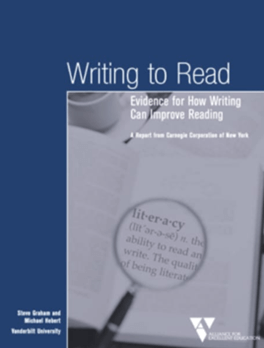
Writing to Read: Evidence for How Writing Can Improve Reading: Evidence for How Writing Can Improve Reading
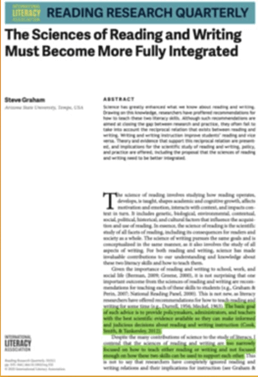
The Sciences of Reading and Writing Must Become More Fully Integrated
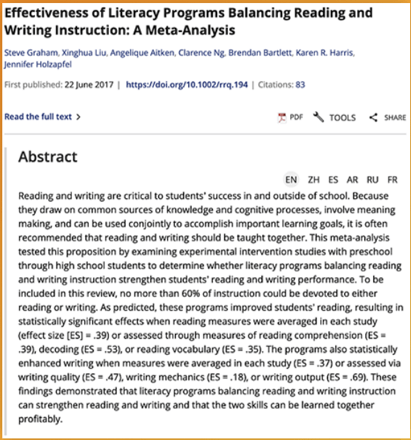
Effectiveness of Literacy Programs Balancing Reading and Writing Instruction: A Meta-Analysis
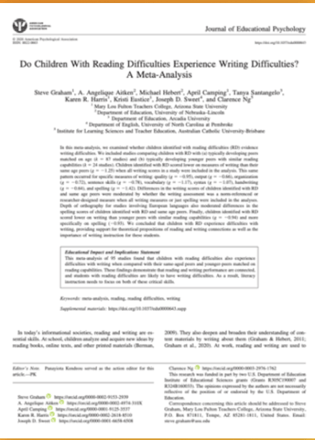
Do Children with Reading Difficulties Experience Writing Difficulties? A Meta-Analysis

About the Author
Randy Barth is CEO of SRSD Online, which innovates evidence-based writing instruction grounded in the Science of Writing for educators. Randy is dedicated to preserving the legacies of SRSD creator Karen Harris and renowned writing researcher Steve Graham to make SRSD a standard practice in today’s classrooms. For more information on SRSD, schedule a risk-free consultation with Randy using this link: Schedule a time to talk SRSD.
